|
Picking Out Puppy
"German Shepherd Dog Puppies For Sale" Picking Out Your Very Own Puppy - Dog 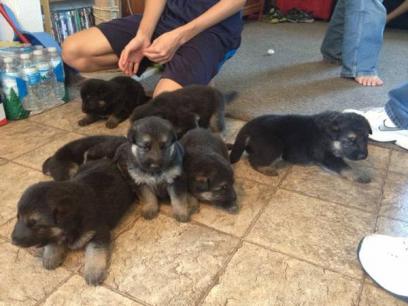
There is much to consider when picking out your German Shepherd Dog (GSD or GSDs) Puppy...and it is not an easy task. There is far more to finding the RIGHT dog than just answering a "German Shepherd Puppies For Sale" or "For Adoption, German Shepherd Puppies" advertisements in your local paper or on an Internet ad.
This photo is actually of some that I was looking at to buy from an ad on the Internet. They sold very quickly and were gone by the time my call reached the owners.
Seriously, I can not say it enough. You have to know what you are looking for. You have to know your own purpose of the dog before you go and look at puppies. You need to know what body type you are looking for, what temperament even sometimes, what color dog you are looking for. How will you know? Look seriously at the parents of the puppies, watch the puppies, listen to the breeder.
If you are looking for a Conformational Show Dog you need to go to a Kennel that is winning, that is 'winning', not just in, the Show Ring. Buy what the Judges (right or wrong) are what the current Conformation Show Judges are looking for in the dogs they are placing in the Ring. Be warned! Every Registered Puppy/Dog out there has Champions in their background...somewhere in their background the CH is going to come up in the pedigree.
If you want a GSD to carry a light weight backpack, you want a puppy for GSD stock that is more squared bodied. Do you want a dog for Schutzhund? Go to a kennel that is participating in these dog events. Study the photos of the dogs doing the type of work you would like for your puppy to grow to do....or what you want your GSD dog to look like.
Search you own heart before searching for a dog to ad to your family that will be with you for about 15 years.
WHEN BUYING A PUPPY, ABOVE ALL, LOOK FOR A REPUTABLE BREEDER!
I THINK THE BOTTOM LINE ON WHAT A "GOOD OR REPUTABLE BREEDER" (and this means any type of animals) IS CAN BE SUMMED UP, NOT BY HOW MANY DOGS THEY OWN, NOT BY WHERE THEY LIVE OR WHERE THEY BREED THEM, NOT BY THE FACT THAT THE DOGS ARE JUST REGISTERED OR HAVE PAPERS (and this is important!)....BUT BY THE KNOWLEDGE OF THE BREED THE BREEDER POSSESSES, BY WHAT THE BREEDER IS DOING WITH THEIR DOGS (working or showing), BY THE KNOWLEDGE OF THEIR OWN DOG'S PEDIGREES (genetic make up and titles within), BY HOW THE BREEDERS DOGS ARE CARED FOR, BY THE WAY THEIR DOGS ARE TRAINED. (this is the short form, please keep reading this page)
Be Wise! Beware! Just Because A Dog Was Imported From Germany, and all GSDs were at one point, so let's say a Recent Import From Germany, DOES NOT MAKE IT A BETTER DOG OVER ONE THAT HAS MANY GENERATIONS OF USA BRED DOGS! Germany did and has and does send their culls to people in the USA.
Dogs bred in Germany must pass several test before they may be bred by law in that Country.
It is true that Germany Dogs must pass tests before they are eligible to breed. But do not for one minute think that Politics are not involved. I know this first hand from another breed of dog, I was involved in a Dog Sport that one of Germany's Breeder "Police" participated in. I know what she put people through before they could breed their dogs and how she picked out the males they could breed to, she seemed to chose her own male quite frequently. Further, be warned that, German Breeders are keeping their best dogs right their in Germany.
There are MANY good and reputable German Shepherd Breeders in every country. In the USA we want to believe that Dog Breeders are all bad people. They are not. Most care very much about their dogs and their dog's health and their own names....ie don't breed just anything so that they get a bad name. Shop around, shop the Internet, keep looking, there are certainly very good, very true, German Shepherd Dog Breeders living right here.
All German Shepherd Dogs, check your pedigree back generations, originally came from Germany. What is important, is the puppy's parents that you are buying your puppy from. Look at the parents, listen to what the Puppies Breeder is telling you about them and about the puppy.
Know what you are looking for in a GSD before you start looking to purchase that puppy you are seeking. Germany Bred Dogs are higher energy, working dogs, out of dogs that have Schutzhund Titles, this also means they have been temperament tested. Most, not all, but many, USA bred GSD are more laid back and larger than the dogs from Germany. If you are more of a "stay at home and watch TV type person, the USA bred dogs may be more for you.
Choosing A Puppy or Dog Over The Internet 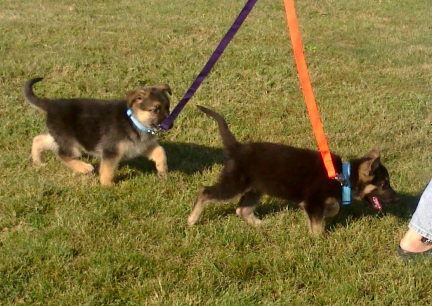
In today's world we look to the Internet for much in our daily lives. When it comes to picking out the right puppy the Internet can really be a help. It used to be, years ago, that you sent snail mail back and fourth with a breeder hoping to see photos and hear more about the dogs you saw in an advertisement in a Magazine. Long distance buying of animals is nothing new at all, it is however faster to get and receive questions answers, see videos and photos. If a Breeder has a website, all the better.
If you are looking for a GSD in your area, do a Internet Search. Expand your area if you are looking for a Working Dog from a Working Kennel and especially if you are looking for a dog to compete with.
Let me repeat what I hope is a resounding theme and you fully understand....THERE ARE NO PERFECT PETS/DOGS/PEOPLE TO BUY THEM FROM. You are NOT going to find a perfect dog, you will however, if you know what you are looking for, and patient, find the dog that is a perfect fit with you and or your household. Further, remember that PUPPIES DO NOT COME FULLY TRAINED, some might be started, BUT IT IS UP TO YOU TO PUT THE TIME AND LOVE INTO YOUR DOG SO THAT IT BECOMES THE DOG YOU ARE DREAMING OF.
So as I have said, Don't Blame The Breeder.....also, Do Not Blame The Internet if your dog grows up and is not trained.
Keep in mind, if you travel to pick up a puppy or if you have it shipped to you, you must consider the cost of getting the puppy to you in the cost of the puppy.
I guess the bottom line is that an ad on the Internet is no different then one in your local paper....except distance. Many times, the ad on the Internet is one where you can read about the person selling, see photos of their dogs, and "virtually" visit their kennel, or home, before you pick up the phone to call them, or send them an email. However, you do have the same "Buyer Beware" warnings you will anywhere you shop.
Look Well At The Puppies Parents Your puppy is going to grow to look like the parents it is 'out of'. You will want to see either the parents in person, or CANDID (natural, not posed) photos of each of the parents and from all sides.
It is common, and don't let them kid you, deliborate, that breeders take ONE Stacked Photo of their dogs for their websites when selling puppies. Why? To make it look better than it really is.
What is Stacking?
"STACKED" = a Posed Dog for a photo, photo is usually taken from the side. However, a Stacked Photo can be taken from any angle. Stacked photos are taken to HIDE Faults. With 'Stacking', not only are the feet posed, that is actually picked up by hand and set exactly where they should be for the breed, (what is known as 'stacked'). Many owners also shifts the weight of the dog from front or to the back of the body, to cover up 'faults' the dog has in front or rear.
Note if the photo of the dogs have people in them and if they are posing the dog, or holding the leash very tightly....
Is the photo of the dog with it's head tilted upward? They are probably tilting the head because the dog's ear is weak of flopped, that is, hound like and very unsightly on a GSD.
Be aware of 'stacked' photos (especially when those are the only photos offered of parents) when you are looking at the parents of the puppy you want to purchase. Another 'photo trick' is when you only see photos of the dog sitting or if part of the dog is blocked from view.....beware! Think of "Stacking the Deck".
KEEP IN MIND: Stacking Dogs for the Conformational Show Ring is Correct and How It Is Done.....but if a breeder is offering no candid shots of the adult dogs....Beware!
Picking Out Your Puppy's Name 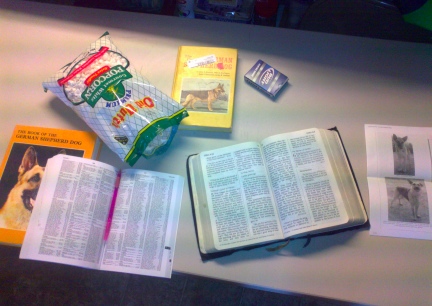
A dog's name matters. Many people do not take the time to think out a name that will be with their dog for an average of 15 years. You want a name you can be proud of. A German Shepherd Dog (GSD or GSDs) needs a honorable name, you would not, for example, name a GSD FeeFee or Snow Ball.
The first thing to take into consideration is how it sounds to the dog. When training you want the dog to have a strong sounding and different type name. Never use a name that rhymes with a training word. Don't use the name Snow, it sounds too much like NO. Do not use the name Bound, it sounds too much like Down...you get the idea.
You also want a strong sounding name, like Rough, or George, rather than John or Bob. The dog needs to hear that name strong, especially when you are training, but when trouble comes, you want the dog to not be confused. A strong sounding name gets the dogs attention fast.
I thought about using the name Shotgun for our GSD. My husband reminded me that the word shotgun is used at our house frequently about guns. We shot here and in different types of gun matches. We shoot shotguns once a week with a local club. So using the word Shotgun as a name for a dog, would not be a good choice for us.
When I had my first GSDs I used Biblical Names that begin with the letter 'T'. I would like to continue that. When I had my first dogs and planned more, the next was going to be named Titus. A name that I believe I will stick with. I am planning to females also. I have one name picked out, but still need another that we both would like to use. Although I want to use the name Titus, I am still open to other names....or at least looking. So I got out my Bible, my Strong's Concordance and a few GSD books and started looking and making notes. The papers with the dog's photos on them are copies off www.DumansArk.com the kennel my two females should be coming from. Just using that for making notes.
Picking Out Your Puppy's Area (in your home, yard and vehicles) 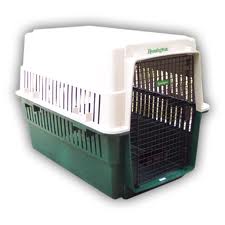
Every dog needs this, it is an important factor ~ Every single dog needs an area that belongs to them. If the dog has a crate set up, it will go to that crate and sleep, and when it needs to feel safe. Never, Ever, Never, let a child get into that Dog's Cate and take the dog's space. It is the dog's space alone.
Crate are wonderful! They will assist in House Breaking your dog. Dog's, if the spacing is right, will not go potty in their own crates. It is much like a wolf or coyote or fox den to the dog. Something in nature, or we say here "God tells them", that this is their bed, not a toilet. If you can buy a couple for your pup and one for the pup when it is full grown, all the better. If a puppy is kept in a crate that is too large, it WILL go potty in the back of that crate, thus teaching the puppy, that it is OK to go potty in a crate. We never feed or water our dogs in a crate. Some people do. It just starts bad habits. We do however, give our dogs a treat, we call them "cookies", a treat made for a dog that is, when the dog goes to it's crate before we leave, and right before the lights go out at night. This teaches the dog to go to the crate, and that the crate, one per dog, is their very own place.
If you can not buy more than one crate for your new puppy. Buy one that the dog, when full grown, will be able to stand up in and turn around. Yes. For a GSD this is going to be a large crate. When the puppy is growing put at cardboard box in the back end of the crate, that will ever become smaller and smaller sized, so that the puppy does not have the full crate to potty in. This will help when housebreaking your dog.
If you have dog books, and you should, most have a section on crates and how to use them correctly for your dog. Read that section. The dog crate is your training companion and a safe place for your dog to be.
Picking Out Your Puppy's Toys 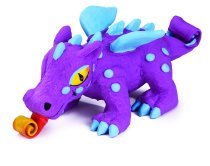
This might sound silly or trivial, but it really is not. If your puppy has proper toys, the size and structure it needs, it, with training, will not chew on your stuff.
Never, ever give a puppy or dog one of your old shoes or old socks, for that matter a new sock, and expect it to know the difference between the old you have given it and the ones that are your favorite. It is not the dog's fault if you taught it something you did not mean to.
Puppies NEED squishy toys to play with and chew on. Puppies chew when they are teething because it feels good to their mouth. Puppies also chew because they have energy and need a place to spend that energy. It is up to you to help them not get into trouble chewing on the wrong things by giving them toys to chew on and teaching them the difference.
Dog Toys do not have to be expensive. You can find dog toys at Garage Sales and Flea Markets and such, look in the Baby Items. One time, many moons ago, I went to this Garage Sale. The lady had a Golden Retriever out in the area with her. She also had baby toys for sale. Lots of them. I bought several, like more than 10 baby squeaky toys for about $1. After I had paid I told her they were for my dogs. She looked at her dog, who had been watching me the whole time, and said "I NEVER THOUGHT OF THAT!".
This is an actual photo of a toy we bought for our GSD puppy.
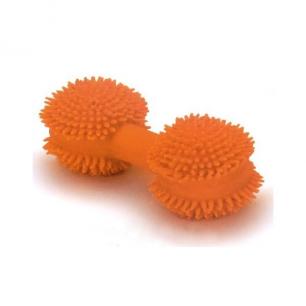 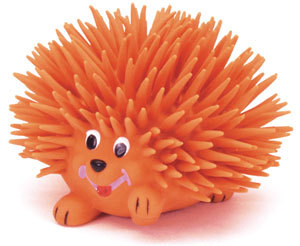
But remember that Latex Toys are a dog's favorite and they last longer than regular rubber. The dogs have a harder time tearing up or chewing latex into pieces the way that they can a rubber toy.
We do not give our dogs Stuffed Animals as toys. Why? Dogs can not tell the difference between the ones you give it to play with and the ones on your bed, or in your child's bedroom. Always remember, what you teach your dog, it will do. Think ahead when you give your puppy something. Do you have others like it, such as a sock, or stuffed animal or pillow, that the dog might misunderstand and ruin? Then do not ever start giving it that type of toy.
Toys with the little nubs on them are not only fun for your puppy and dogs, they help clean between their teeth and give teething puppies a little extra area to sooth their teeth on. Give your dog a variety of safe toys and let them pick their favorite. Our dogs like the ones that we will throw for them to go and fetch. <grins and winks>
Have you seen the toys that a person puts a goo into or the ones that a person puts little treats into? The rubber ones would be alright, if washed frequently in warm soapy water and rinse well, but the hard plastic....when you have a dog with jaw strength as a GSD, that toy might get chewed and break, causing small sharp pieces. Just inspect any toy for your dog with things like this in mind. And before buying the rubber ones that food goes into, ask yourself if you are really going to keep that clean, remember how nasty that could become.
Picking Out Your Puppy's Trainer 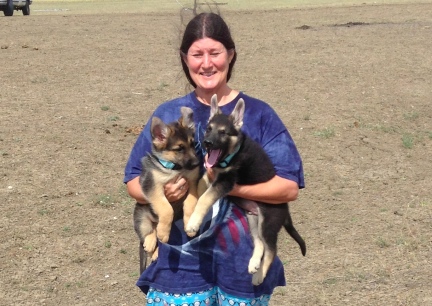
When you bring home a puppy, you have chosen it's primary Trainer ~ YOU! You have a responsibility to the dog, your family, your neighbors, and yourself to train that dog so that it becomes a part of your society. Seriously. It is your responsibility to start and continue that dog, just as with a human child, to be PART of the world around it. If you do not train and your dog barks all the time, lunges at people at your fence line, jumps the fence and runs the neighborhood....IT IS NOT THE DOG'S FAULT ~ IT IS NOT THE BREEDERS FAULT.
Training as I have said before, begins the minute you own that puppy or dog. Don't spoil that puppy. Love it, bond with it, and for sure TRAIN IT!
Most Basic Obedience Classes do not begin until a puppy is about 4 to 6 months old. Until then you do need to get your puppy out and about and socialized. You will need that puppy to know a few commands and how to behave on a leash.
When the puppy is old enough, and if you want to take the training forward or formal from there, start looking for classes in your area. Ask at Pet Stores, check the Internet for classes in your area.
You might want to go and watch the Trainer conduct a class or two before signing up.
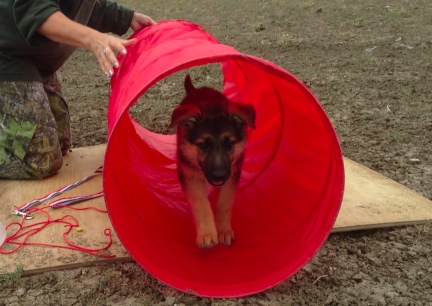
Keep in mind that the classes will be teaching you too. Wear comfortable shoes that will stay on your feet and you can run in. Wear loose fitting clothing so you can bend over to your dog and move about easily. Take to classes whatever the Instructor asks you to bring.
A word on sending you dog off to training. This can be good or very very bad. You need to know something about the trainer you are sending your dog to. Make sure the dog will be worked a couple of few times a day and not just sitting in a cage. From the beginning, when you first check out the trainer and their facilities, write everything down in a notebook. Keep notes. Learn what this person is telling you. When you are asked to come out and learn what how to work your dog, GO, and take a video camera with you and someone to record all that goes on. It will be overwhelming for you to learn in just that short time. What will you have if you do not learn how to work your dog? A very large bill and a dog you can not work with.
Start Basic Training As Soon As You Take Your Puppy Home 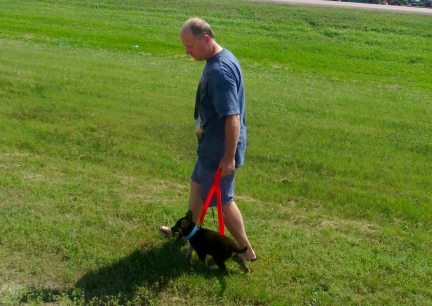
The minute you load your new puppy or dog into your vehicle for the ride home, start treating it/training it as you want it to become. In other words, do not let the puppy ride in your lap as you drive now and want it to ride in a Large Crate in the back when it is older. Whatever you do now, is what the dog will expect. If the dog will ride in a crate in the back, take a crate with you when you go and look at puppies. When you load the puppy for the first time, give the command you will use for the dog to load, such as, "Load." or "Take your place", or whatever command you will use.
When you get the puppy or dog out at home, use the command you will use for the dog to come out of the vehicle....and have one. That is the safest thing you can do. This way, if there is a loose dog, another vehicle coming, a person with a small child, whatever you might not want your dog in the middle of the moment it exits the vehicle, wait til safe and give the command.
Take your dog/puppy home. Do not do a tour to show it off. Give it a chance to get used to you and all these new things going on in it's life. Remember, all it knew before you was one home, it's dog mother, it's siblings, and the home it lived in. You will also want your puppy to have all of it's vaccinations before taking it out around other dogs, and places where other dogs have been. That said, this is a photo of our GSD, Titus. It was taken on the long, day long, ride home from his breeder to our home. I was thrilled he learned to walk on a leash so easily and fast and well. It looks, in the photo, as if Deron has Titus in a "Heel", he does not. It is just where Titus is walking along with Deron.
When you get the dog/puppy home, have it go potty before taking it in the house. Don't overwhelm the new dog with too many visitors. Start training right away.
The next morning, or later that day, fill out your paper work for registration or other papers the breeder might have given you. Start a folder or large envelope for this dog with it's name on the front and keep all of the dog's information and health records and training information in it. Place this folder with our other business papers, such as house papers, insurance papers, and such. Not only is this a good practice for you, and you will know where all the dog's papers are, if something were to happen to you, this could mean the difference of your dog getting another good home, or it being "dumped" because your family did not know anything about the dog other than what you had told them verbally.
When you get the puppy home, and especially a large breed that will be a working dog, do not spoil it. If the dog will not be allowed on the couch when it is full grown or when it is muddy (dogs do not know the difference between clean and dirty) DO NOT LET IT ON THE COUCH AS A PUPPY! If the dog will not be allowed to jump on people when it is full grown, do NOT allow the puppy to do so from the start.
Start training your puppy right away. Yes. Puppies that are 6, 7, 8 weeks old, CAN & DO learn to "sit" on command. Teach your puppy to sit when you feed it or give it a treat. Teach you puppy to walk on a leash right away. Some hate it, some are like a fish out of water the first few times. But if taught correctly, your puppy will walk on a leash, even the first time out, as if it has done this a million times before.
Every action you want your dog to do or become as a dog, starts the minute you load it into your vehicle. Don't spoil the puppy and get angry with it when it is about 4 - 6 months old because it is big and clumsy and rude.
Buy and book on training, read on line, start your puppies manner training right away.
By starting right away and being consistent with your dogs training, you are raising a dog you can be very proud of. You are raising a dog your family and friends will be happy to be around and perhaps envious of. And once this well behaved pup is a bit older, all the work you are hoping this dog will perform, you are most of the way teaching it. The hard part of training a working dog, is that basic training. Once it learns to learn, once it learns to please you, all else goes quickly and easier as far as training. Just don't get in a hurry to get to that point.
Start the minute you pay for the puppy. Everything you expect from your dog, teach it as a puppy or dog as soon as you own it. Reread the above paragraph on How To Raising Your Working Dog. It is not Rocket Science, but you must be consistent, fair, consistent, loving, consistent, know what you want the dog to do and how to act and teach/train the dog to get it to those expectations, and be consistent.
Puppy Classes and Basic Obedient classes are not just to teach the dog to "sit" and "heal.". Obedience Classes are a great place for someone else to see the mistakes you are making with your dog, a great place to learn how to teach your dog, a great place for your dog to learn to behave in public, a wonderful place for your dog to learn to learn, the best place for your dog to learn to work around other dogs, a place where your dog learns you are the boss and to focus on you. From there you can take more classes or just get your dog out and about and around people and other dogs. And or start working your dog toward the job it will have.
PLEASE KEEP IN MIND, THAT MANY BREEDS, ESPECIALLY THE LARGE AND EXTRA LARGE, WILL TAKE A FEW YEARS BEFORE THEY CAN BE EXPECTED TO CARRY BACKPACKS AND OR PULL AND OR DO THE JOB YOU ARE ASKING IT TO DO. PUPPIES TAKE TIME TO GROW AND MATURE BEFORE THEY ARE DOGS. AND BEFORE THEY ARE DOGS, THEY ARE NOT READY FOR A FULL TIME JOB. THERE IS A REASON THE WORD "PUP" IS USED FOR ANY DOG TWO YEARS OLD AND UNDER. Don't hurry your dog. Training, wonderful and useful, too much work, could harm the dog physically and mentally.
If you have a Training Book on the type of training you would like to put into your dog, reread it, yes, even if you have trained many dogs to do this same job. If you do not have a book on training the dog to do the work you would like for it to perform, buy a few. On line reading is fine, but you have to be at your computer to do that. Having that book here and there, like taking it with you in your vehicle and reading it when you get them time, better.
Read, read, talk to people that have and are training their working dogs to do the same type work you would like for your dog to do. Join elists and forums. Learn, learn, lean. You have to learn before you can train or teach your dog.
Obedience Training is the basis for all dog's. All dogs. Pets, or working dogs, they all need that basic training. Further, that basic training teaches your dog to learn. Once they learn to learn, they catch on quicker to what you want them to do.
Many people "send their dogs out for training". And that is great. Just make sure you schedule time to learn how to work your own dog when it gets home. Spend the time, take notes, listen to what the Trainer is telling you. If you do not learn what the dog has learned, if you do not use the correct commands, all that money and your dog's time away, was for nothing. You will be very frustrated.
Picking Out Your Puppy's Dog Tag 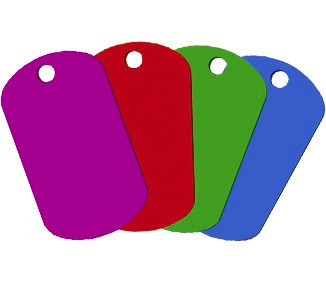
This sounds so trivial. It sounds like a "no brainier". But there are things to think about when picking out your dog's Dog Tag. Every dog should have tag. They now make a shape and color to please every Dog Owner.
Many people think that with a microchip, their dog does not need a tag. Wrong!. The average person does not keep a Microchip Reader in their home or vehicle and the average person knows very little about Microchips anyway. You dog wearing the right tag could be the very thing that brings your dog home, safe and sound and free of charge.
You do NOT want to print the Dog's Name or Your Address on your dog's tag. Why? If the wrong person finds or even steals your dog, you do not want that person to know your dog's name. You do not want the dog responding to that person because it recognized it's name being called or said by this person. You never want your address on your dog's collar. If someone finds your dog, they know your dog is not at home to stop them from robbing you. Yes. This really has and does happen.
All you want on your dog's tag is your telephone number, perhaps your last name.
If your dog is not wearing a tag and gets loose in your area, someone finding the dog and wanting to help, can't. So they will call the Sheriff or Pound and take the dog in to them. You will pay a fine if you have to go and pick up your dog if it is "turned in". If your dog has a telephone number on it's tag, a person can call you right away and you can go and pick up your dog. Go. Do not have the person bring your dog to you.
If you do not like the noise the tags make while your dog is wearing them, you can do two things. Buy the rubber that goes around them to "silence" them, or add a hole at the other end of the tag and mount it on your dogs collar on both ends of the tag. I like my dog's tags to "ring". I can set my dog's up with different sized tags and tell the dog's apart by the sound. This way at night, if you hear one moving around, you can use the correct Dog's Name to have it "go lay down".
Tags come in colors now. If your dogs look a like, or if you have several dogs of the same breed, even just two, when you have people come and care for your dog, you can write down what the name of each dog is and identify them by the colors of their collars and or tags. This will help someone keep them straight while you are away. Or if family and or friends can not keep your dog's faces with their names. This will help them.
Your Rabies Tag can identify your dog. But again, this has to be done through a vet or pound. You will pay fees. If your dog has a tag with your telephone number on it, chances are your dog will be found and returned right in your own area. A Dog Tag can save you a trip to town as well as a fee. Buy one today.
What To Take With You When You Pick Up Your New Puppy When the day comes to pick up your puppy there are some items you will need to take with you, there are some items you might want to take with you, it depends on how far a drive it is from your home.
You will NEED to take a couple of Bath Towels and or older Blankets. Your puppy has probably never ridden in a vehicle before, at least not without the rest of it's family with it. You puppy might be scared and it will probably be stressed, it has just left everything it has ever known. That and the fact that many puppies get Car Sick, or Motion Sick, towels and or blankets can be very necessary for the ride home.
It is a good idea to take a small, think cat sized, Crate with Newspaper Liners and a Towel or old Blanket over the Newspapers so the puppy does not slide around as badly.
Your puppy, depending on how far of a drive it is, might need to get out and walk about and go potty. Take a couple of Plastic Bags with you for picking that mess up. Puppies normally have "two pees and a poop". Wait til your puppy does when you are walking it.
Depending on the area and age of your puppy, it would be a good idea, and might be the Law in your area, to have a Collar and Leash for the puppy to walk on when you stop for potty breaks.
If you have a long drive home. Take a couple of small Bowls and a bit of Food and Water for your puppy.
You might want to take a bit of Shampoo with you. If your puppy gets sick or goes potty in the crate or on your lap, you are going to want to clean that puppy up and clean it up quick. Without having Water and Shampoo with you, this could be a trick.
And if that puppy would happen to go potty or throw up on you.....you might want to carry a Change of Clothes with you also.
Any time you are out with animals, not matter how far your are going, be prepared for anything that can happen... you just never know.
The contents of this page for Picking Out Puppy is still under construction. Please check back.
I would like to invite you to join us on a Yahoo Group that I host called Working Big Dogs. -- The Working German Shepherd Dogs Team
Tue, 30 Jul 2013 13:44:42 -0400
| 


 In the high plains of South Dakota, USA
In the high plains of South Dakota, USA In the high plains of South Dakota, USA
In the high plains of South Dakota, USA